Research - (2020) Advances in Dental Surgery
Awareness Among Pursuing Career Among High School Students
Malavika Pradeep, Dhanraj Ganapathy* and Keerthi Sasanka
*Correspondence: Dhanraj Ganapathy, Department of Prosthodontics, Saveetha Dental College, Saveetha institute of Medical and Technical Sciences, Saveetha University, Chennai, India, Email:
Abstract
Career selection is one of many important choice’s students will make in determining future plans. This decision will have a great impact over their lives throughout. “Work is one of our greatest blessings. Everyone must have an honest occupation”. Many high schools are devoting more resources to improving student awareness of education. The aim of the present study is to create awareness about pursuing a career among high school students. A questionnaire containing 10 questions was made and then circulated on an online platform. The questions are close ended type mostly. The data collection software used is survey planet. The survey was answered by 101 people. The results are converted into graphical form for easy understanding as follows. The collected data was represented in the form of pie charts. The statistical software used is SPSS software. Most respondents were aware on the various factors that affect their career choice.
Keywords
Career, Occupation, Students
Introduction
Career selection is one of many important choice’s students will make in determining future. This decision will have a great impact over their lives throughout. “Work is one of our greatest blessings. Everyone must have an honest occupation” [1]. Student’s education will also be affected by their parent’s educational background. There are various environmental factors that can influence a student in their career decision. It is essential to have a good understanding of yourself, your personality, if you really have to make good career plans [2]. Opportunity is another factor that influences career choices for students. Opportunity influences how students perceive their future. The issue of poverty plays an important role in the opportunities available to all. Students want to be treated as the adults they are expected to become, on an equal opportunity basis, so that they can make the best possible career choices. In Laleger’s study that was done in 1942 shows that gender bias, and studies related to it is a part of the career choice process [3]. Kroll has provided models of the decisionmaking process. John Dewey’s model has five noticeable steps described: the preflective state, intellectualization, suggestions, reasoning and then hypothesis [4]. Psychological testing, one means of helping a student focus on an appropriate career choice, resulted in better employment records, as shown for example in the stability, promotions earnings, and employer ratings throughout the student’s career [5]. In most of the literature concerning career choice, the need for students to investigate is discussed. The student must have investigated, brainstormed, and tried alternate methods, rather than giving in to the first opportunity available. The student must not have been satisfied with the easiest opportunity that comes along. In fact, the constant career exploration could be adopted as a lifelong strategy throughout one’s life [6]. In further studies done by researchers, it was revealed that youth who are motivated by intrinsic factors are driven by their interests in certain employments, and professions that are personally satisfying [7,8].
Career choice is an important decision taken in life which requires active seeking of information to arrive at an informed choice. Many high schools are devoting more resources to improving student awareness of education. Students simply do not understand the college search process or the resources that are available to them to research the higher ed programs and career options that are available. With a huge counseling gap (the national average is 1 counselor to 495 students), it is no wonder that a majority of the students are not able to navigate their way to success. And, with 65% of students attending rural and urban school districts, the problem may be even worse than we know. Previously our department has published extensive research on various aspects of prosthetic dentistry [9–19], this vast research experience has inspired us to research about the present study, awareness about pursuing a career among high school students. The aim of the present study is to create awareness about pursuing a career among high school students.
Materials and Methods
A questionnaire was prepared with all questions regarding my question was transferred into a survey and the survey was circulated on the online platform. Sampling method is random sampling and sampling size is 100. The questionnaire was a self-questionnaire which consists of close and open-ended questions. The data collection software used is survey planet. The type of analysis used here is percentage analysis. The method of representation of data is pie chart and bar graph. The results are converted into graphical form for easy understanding. The independent variable of the study includes geographical area. The dependent variable of the study includes age, gender, and knowledge.
Results and Discussion
A questionnaire was prepared, and it was circulated as a survey on an online platform. The survey was answered by 101 people. The Result of the present study is as follows - According to Figure 1, 56.38% of the participants have good knowledge regarding career choice and 43.62% does not have much knowledge regarding career choice. According to Figure 2, 52.04% are happy with their choice in career and 47.96% are not happy with their choice in career. According to Figure 3, 55.56% of the participants were pressurized in choosing their career and 44.44% of the participants were not pressurized in choosing their career. According to Figure 4,19% responded to friends, 40% responded to parents, 6% responded to social media and 35% responded as teachers as their factors in choosing a career. According to Figure 5, 66% of the participants agree that boys mostly choose engineering and 34% do not agree that boys mostly choose engineering. According to Figure 6, 26% like to become an engineer and 22% like other jobs. Majority of the participants want to become a doctor. According to Figure 7, 61% of the participants are female and 39% of the participants are male.
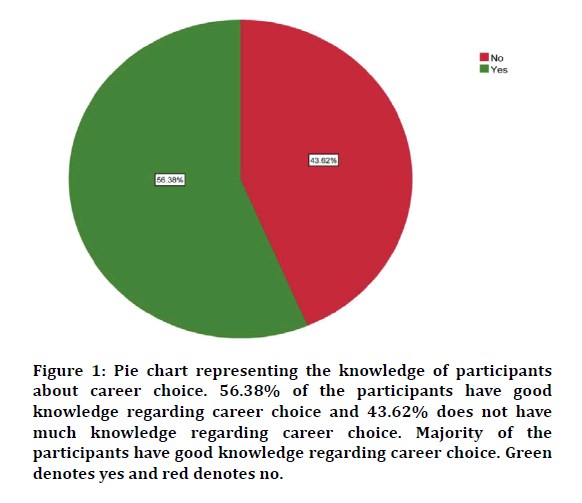
Figure 1: Pie chart representing the knowledge of participants about career choice. 56.38% of the participants have good knowledge regarding career choice and 43.62% does not have much knowledge regarding career choice. Majority of the participants have good knowledge regarding career choice. Green denotes yes and red denotes no.
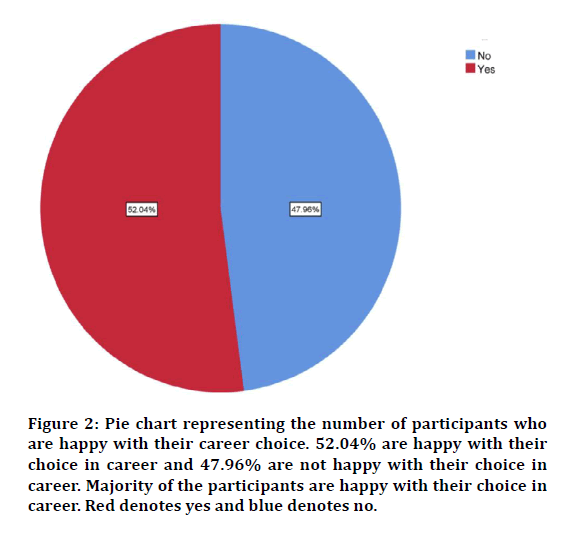
Figure 2: Pie chart representing the number of participants who are happy with their career choice. 52.04% are happy with their choice in career and 47.96% are not happy with their choice in career. Majority of the participants are happy with their choice in career. Red denotes yes and blue denotes no.
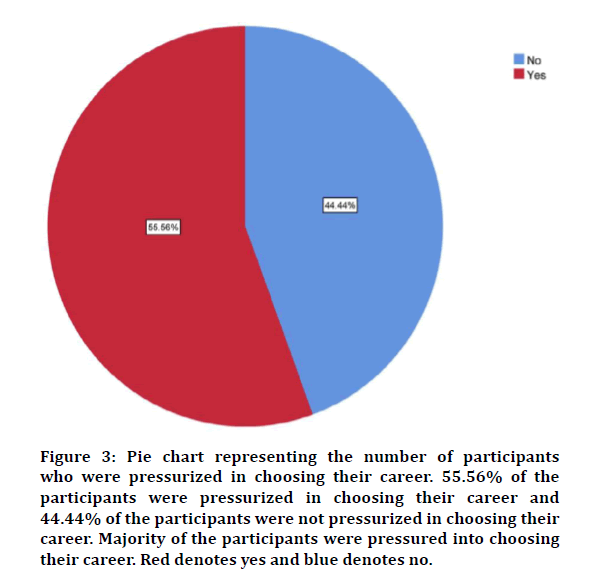
Figure 3: Pie chart representing the number of participants who were pressurized in choosing their career. 55.56% of the participants were pressurized in choosing their career and 44.44% of the participants were not pressurized in choosing their career. Majority of the participants were pressured into choosing their career. Red denotes yes and blue denotes no.
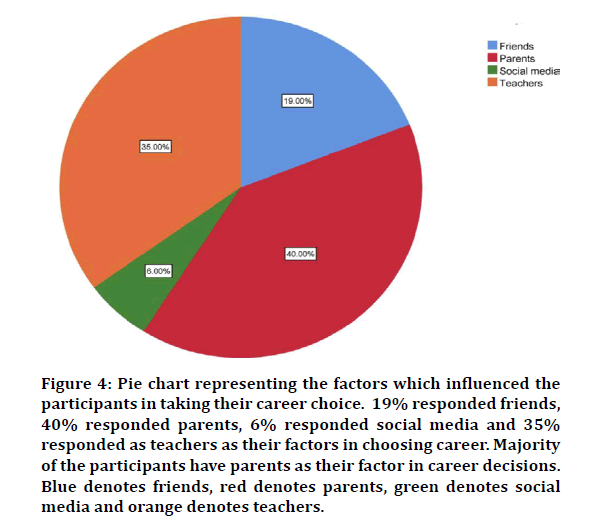
Figure 4: Pie chart representing the factors which influenced the participants in taking their career choice. 19% responded friends, 40% responded parents, 6% responded social media and 35% responded as teachers as their factors in choosing career. Majority of the participants have parents as their factor in career decisions. Blue denotes friends, red denotes parents, green denotes social media and orange denotes teachers.
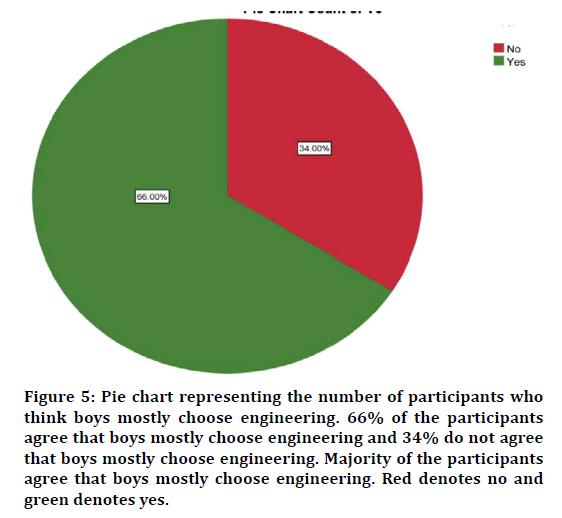
Figure 5: Pie chart representing the number of participants who think boys mostly choose engineering. 66% of the participants agree that boys mostly choose engineering and 34% do not agree that boys mostly choose engineering. Majority of the participants agree that boys mostly choose engineering. Red denotes no and green denotes yes.
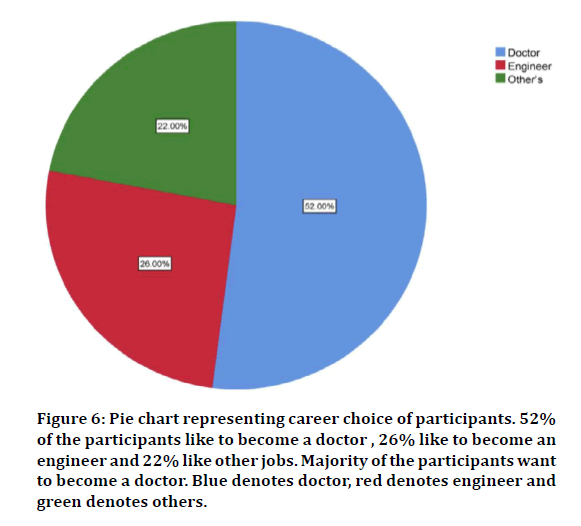
Figure 6: Pie chart representing career choice of participants. 52% of the participants like to become a doctor , 26% like to become an engineer and 22% like other jobs. Majority of the participants want to become a doctor. Blue denotes doctor, red denotes engineer and green denotes others.
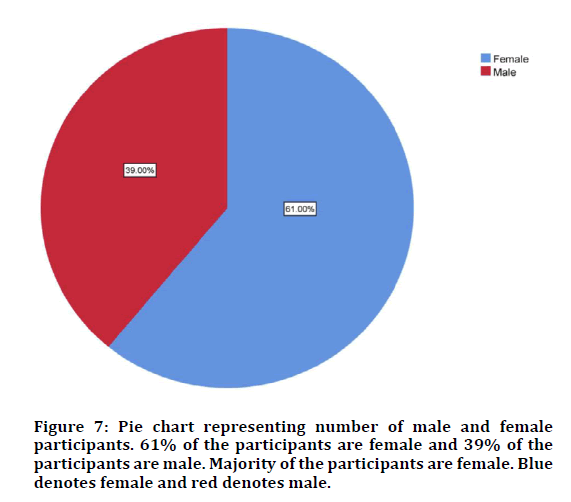
Figure 7: Pie chart representing number of male and female participants. 61% of the participants are female and 39% of the participants are male. Majority of the participants are female. Blue denotes female and red denotes male.
In the present study, according to Figure 2, 52.04% are happy with their choice in career and 47.96% are not happy with their choice in career. In previous studies, results were found that American adolescents often have unrealistic occupational aspirations and the job opportunities that were likely to be available to them did not match with their expressed interests [20]. In a survey study in Hong Kong, 28% respondents reported that they were interested in studying nursing. In the present study, according to Figure 5, 66% of the participants agree that boys mostly choose engineering and 34% do not agree that boys mostly choose engineering. In previous studies, the findings stated that the students’ decision to not choose or choose nursing was significantly influenced by the demographic factors:, biology subject pursued, gender, mother's occupation, previous academic achievement and their perception of nursing as a career [21]. In a statement given by Marcia Greenberger (2002) of the National Women’s Law Center, it was said that girls were expected to cluster into the traditional fields of cosmetology, childcare, and similar jobs and boys are still being steered toward the traditional ‘male’ jobs, which are higher paying. In Florida 99% of the students in cosmetology are female, while 100% of the students taking plumbing are male while 99% of the students in cosmetology are female [21,22]. In present study, according to Figure 4, 19% responded friends, 40% responded parents, 6% responded social media and 35% responded as teachers as their factors in choosing career. In previous studies, it was found that higher career congruence with parents have also increased the career confidence and self-efficacy [3,23]. In the process of youth’s career decision making, teachers and educators are significant figures [24,25]. Questions were asked such as if the students have a good knowledge about their career before choosing it, did they like their choice in career, were they pressurized in choosing their career, factors which influenced their choice in career etc. These questions were answered by many students. From the result it is understood that most of the high school students are aware about career choices but still there are students who are sure about their career decisions or those who do not have much information regarding it. They still must know more about career choices and need to be given their own choice in choosing their career. Limitation of the study is that the sample size is 100 which is less. In future more numbers of people and other groups of population can also be added.
Conclusion
The present study was done to create awareness about pursuing a career among high school students. Most of the high school students are aware about career choices but still there are students who are not sure about their career decisions or those who do not have much information regarding it. Students must give more importance towards their decision in their career.
References
- O’Brien T. A case study of six students in workbound. 1996; 682.
- Splaver S. Your personality and your career. Julian Messner 1977; 190.
- Sawitri DR, Creed PA, Zimmer-Gembeck MJ. Parental influences and adolescent career behaviours in a collectivist cultural setting. Int J Educ Vocat Guidance 2014; 14:161–80.
- Mogami T. International career development of academics: An early career counseling psychologist’s professional journey from New York to Tokyo. Psyc Extra Dataset 2008.
- Tims M, Akkermans J. Job and career crafting to fulfill individual career pathways. Career Pathways 2020; 3:165–90.
- Anonymous. Personal view: Communication is the key to quality care. BMJ 2000; 321:0008301a.
- Gokuladas VK. Factors that influence first‐career choice of undergraduate engineers in software services companies. Career Develop Int 2010; 15:144–165.
- Kunnen ES, Saskia Kunnen E. The effects of career choice guidance on identity development. Educ Res Int 2013; 2013:1–9.
- Anbu RT, Suresh V, Gounder R, et al. Comparison of the efficacy of three different bone regeneration materials: An animal study. Eur J Dent 2019; 13:22–28.
- Ashok V, Ganapathy D. A geometrical method to classify face forms. J Oral Biol Craniofac Res 2019; 9:232–235.
- Ganapathy DM, Kannan A, Venugopalan S. Effect of coated surfaces influencing screw loosening in implants: A systematic review and meta-analysis. World J Dent 2017; 8:496–502.
- Jain AR. Clinical and functional outcomes of implant prostheses in fibula free flaps. World J Dent 2017; 8:171–176.
- Ariga P, Nallaswamy D, Jain AR, et al. Determination of correlation of width of maxillary anterior teeth using extraoral and intraoral factors in Indian population: A systematic review. World J Dent 2018; 9:68–75.
- Begum R, Ariga P, Jain AR. Evaluation of corrosive behavior of four nickel–chromium alloys in artificial saliva by cyclic polarization test: An in vitro Study. World J Dent 2017; 8:477–482.
- Ranganathan H, Ganapathy DM, Jain AR. Cervical and incisal marginal discrepancy in ceramic laminate veneering materials: A SEM analysis. Contemp Clin Dent 2017; 8:272–278.
- Jain AR. Prevalence of partial edentulousness and treatment needs in rural population of south India. World J Dent 2017; 8:213–217.
- Duraisamy R, Krishnan CS, Ramasubramanian H, et al. Compatibility of nonoriginal abutments with implants: Evaluation of microgap at the implant-abutment interface, with original and nonoriginal abutments. Implant Dent 2019; 28:289–295.
- Gupta P, Ariga P, Deogade SC. Effect of monopoly-coating agent on the surface roughness of a tissue conditioner subjected to cleansing and disinfection: A contact profilometric study. Contemp Clin Dent 2018; 9:122–126.
- Varghese SS, Ramesh A, Veeraiyan DN. Blended module-based teaching in biostatistics and research methodology: A retrospective study with postgraduate dental students. J Dent Educ 2019; 83:445–450.
- Ali SR, Brown SD, Loh Y. Project HOPE: Evaluation of health science career education programming for rural latino and european american youth. Career Develop Quarterly 2017; 65:57–71.
- Law W, Arthur D. What factors influence Hong Kong school students in their choice of a career in nursing? Int J Nurs Stud 2003; 40:23–32.
- Johnson OJ. Still separate, still unequal: The relation of segregation in neighborhoods and schools to education inequality. J Negro Educ 2014; 83:199.
- Sawitri DR, Creed PA. Perceived career congruence between adolescents and their parents as a moderator between goal orientation and career aspirations. Personality Individual Differences 2015; 81:29–34.
- Yamashita T. Career decision-making in college students: Cross-cultural comparisons for Japan and Korea. Psychol Reports 1999; 84:1143.
- Howard KAS, Ferrari L, Nota L, et al. The relation of cultural context and social relationships to career development in middle school. J Vocat Behavior 2009; 75:100–108.
Author Info
Malavika Pradeep, Dhanraj Ganapathy* and Keerthi Sasanka
Department of Prosthodontics, Saveetha Dental College, Saveetha institute of Medical and Technical Sciences, Saveetha University, Chennai, IndiaCitation: Malavika Pradeep, Dhanraj Ganapathy, Keerthi Sasanka,Awareness Among Pursuing Career Among High School Students, J Res Med Dent Sci, 2020, 8 (7): 93-97.
Received: 15-Sep-2020 Accepted: 15-Oct-2020 Published: 22-Oct-2020
